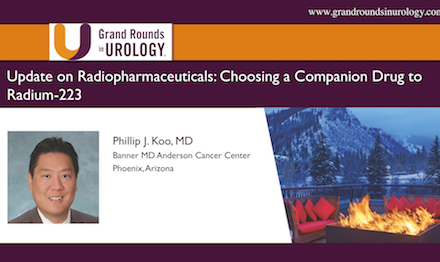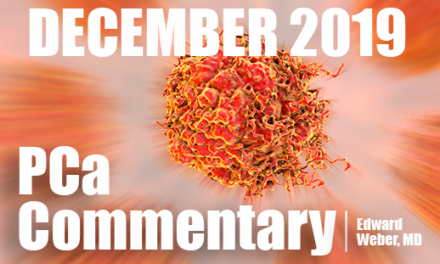
PCa Commentary | Volume 194 – October 2024
Posted by Edward Weber | October 2024
The EMBARK TRIAL: Enzalutamide (Xtandi) Monotherapy for Non-metastatic Hormone Sensitive Prostate Cancer.
The Basics – What is Non-metastatic Hormone-sensitive Prostate Cancer (nmHSPC)?
This disease state is termed M0 (no metastases) in staging terminology. It refers to a rising PSA following primary therapy (including salvage radiation post-surgery) which is negative on imagining with CT, bone scan, and MRI and untreated with androgen deprivation therapy (ADT). When occurring in high-risk patients (Gleason Score 8-10 or a PSA doubling time <9-12 months), this state is frequently associated with micro-metastases below the sensitivities of conventional imaging, but often is positive on PET scanning.
EMBARK TRIAL – Study Details:
The trial studied 1068 men high-risk for recurrent cancer, untreated with hormone suppression, whose PSA doubling times were 9 months or less. The study excluded men who showed metastases on CT, bone scan, or MRI and who were not candidates for post-prostatectomy salvage radiotherapy. Prior exposure to neoadjuvant or adjuvant ADT of no more than 36 months was allowed. The dose of enzalutamide was 160 mg orally daily and for Lupron 22.5 mg by injection every three months. The treatment was given for 37 weeks and then interrupted if a good response had been achieved – otherwise, it was continued. Treatment was restarted at PSA >5 ng/mL in men post-radiation and at 0.2 ng/mL in men post-prostatectomy and continued until the end of the trial. The major endpoint was metastasis-free survival. Additional markers of progression and deterioration in quality of life were recorded.
Adverse effects of the drugs in the EMBARK trial:
In a discussion of the EMBARK trial among a panel of experts presented on URO Today regarding the comparison of adverse effects, enzalutamide alone or in combination was favored for the preservation of bone density, sexual interest, and sexual performance, and prevention of hot flushes, visceral adiposity, and sarcopenia. A major adverse effect of enzalutamide is breast enlargement, tenderness, and nipple pain. This unwelcome development can be prevented or ameliorated by pre-treatment low-dose radiation (10 – 20 gray) administered 1 or 2 times, or by the oral selective estrogen moderator, Tamoxifen.
Less recognized is that enzalutamide raises serum testosterone. In this study men’s serum testosterone was raised from a median baseline of 350 ng/dL to between 450 to 530 ng/dL. Lupron alone or in combination, as expected, lowered serum testosterone to 20 – 30 ng/dL. The elevated serum testosterone due to enzalutamide causes an increase in serum estrogen because estrogen in men results from enzymatic conversion from testosterone. The elevated estrogen leads to these unwelcome breast-related adverse effects.
Results:
The EMBARK trial established that enzalutamide alone or in combination with Lupron was superior to Lupron alone in this cohort of men with non-metastatic hormone-sensitive prostate cancer. The risk reduction for developing metastases for the combination was 57% and for enzalutamide alone was 37% as compared to Lupron alone. Based on these results, the FDA approved enzalutamide monotherapy and in combination with Lupron as studied in the EMBARK study. The National Comprehensive Cancer Network supports both regimens in men with similar characteristics as in the EMBARK trial.
Updated Details for interpreting the EMBARK trial:
Armstrong et al. (JCO. 2023.) presented an updated analysis of the staging of men in the trial: “PSMA PET findings in an “EMBARK-like” cohort of patients with high-risk non-metastatic hormone-sensitive prostate cancer …” The EMBARK trial was conceived and started in 2016 before the widespread use of PSMA-PET/CT. Armstrong studied a cohort of 146 men with characteristics like those in EMBARK who had been studied by PET at diagnosis from five prospective studies at UCLA. Armstrong’s study concluded that 83% of men in the EMBARK trial would have been PET positive with 40% showing disease spread beyond the prostate, including >20% having 5 or more distant lesions. By contemporary standards those men with PET+ aggressive disease having >5 lesions would currently be treated with a doublet such as enzalutamide plus Lupron; those with <5 lesions might receive metastasis-directed therapy (MDT) with or without systemic hormone suppression (continuously or intermittently); and the 20% or so who were negative on PSMA PET scan might employ enzalutamide alone or with Lupron — or possibly choose to delay treatment.
Is early systemic treatment the optimal option for a rising PSA or can therapy be delayed and achieve a similar overall survival?
The EMBARK trial established that early systemic therapy prolonged metastasis-free survival for the specific group studied. In this early treatment scenario at stage M0, if metastases are later documented, alternate therapies would then be applied until the ultimate “overall survival” event, i.e., death.
Surprisingly, there is no consensus as to when to initiate therapy in men with a rising PSA following primary treatment. It is unknown whether an equivalent overall survival can be achieved by withholding treatment during a rising PSA, monitoring carefully then treating when metastases are documented – especially when metastases can be documented with the PSMA PET’s increased detection sensitivity. This delayed treatment regimen establishes a duration termed “treatment-fee survival” as opposed to the duration of “metastasis-free survival” in which treatment is initiated during the rising PSA at stage M0 at an arbitrary point when no metastases have been documented.
As noted above, Armstrong’s retrospective analysis of EMBARK based on PSMA PET/CT analysis found that about 80+% of the study group already were metastatic, leaving only ~ 20% applicable to the question of “when to treat.” (As discussed by Armstrong et al, ASCO, Genitourinary Cancer, Poster Session, #5091) linked below.
https://doi.org/10.1200/JCO.2023.41.16_suppl.5091 [Control+Click link to follow]
The issue of “when to treat” involves a complex balancing of a longer duration of hormone suppression with its associated toxicity (as would occur with early treatment initiated at an asymptomatic condition) versus delayed treatment carrying the risk of symptomatic metastases developing before treatment is initiated. This issue was discussed in full detail with an accompanying explanatory graph comparing the two regimens as to overall survival in “Metastasis Free Survival Versus Treatment-Free Survival in Biochemically Recurrent Prostate Cancer: The EMBARK Trial,” Einstein et al. JCO., May 2024 linked below.
https://ascopubs.org/doi/10.1200/JCO.24.00279 [Control+Click link to follow]
Only properly designed future trials can clarify if a regimen aiming to prolong the development of metastasis can achieve a better overall survival rate than a regimen delaying intervention and treating later.
BOTTOM LINE:
The EMBARK trial offers a useful model of options as to how to treat stage M0 patients who are at high risk for recurrence because of rapidly rising PSA values. Additional analysis of EMBARK found that 80+ % of men were already positive for metastases by PET/CT. The issue of when to initiate treatment for the remaining ~20% in EMBARK and other men with rising PSAs negative on scanning is complex and awaits clarification.
Your comments and requests for information on a specific topic are welcome e-mail ecweber@nwlink.com.
Please also visit https://prostatecancerfree.org/prostate-cancer-news for a selection of past issues of the PCa Commentary covering a variety of topics.
“We appreciate the unfailing assistance of the librarians at Providence/Swedish.”
ABOUT THE AUTHOR
Edward Weber, MD, is a retired medical oncologist living in Seattle, Washington. He was born and raised in a suburb of Reading, Pennsylvania. After graduating from Princeton University in 1956 with a BA in History, Dr. Weber attended medical school at the University of Pennsylvania. His internship training took place at the University of Vermont in Burlington.
A tour of service as a Naval Flight Surgeon positioned him on Whidbey Island, Washington, and this introduction to the Pacific Northwest ultimately proved irresistible. Following naval service, he received postgraduate training in internal medicine in Philadelphia at the Pennsylvania Hospital and then pursued a fellowship in hematology and oncology at the University of Washington.
His career in medical oncology was at the Tumor Institute of the Swedish Hospital in Seattle where his practice focused largely on the treatment of patients experiencing lung, breast, colon, and genitourinary cancer and malignant lymphoma.
Toward the end of his career, he developed a particular concentration on the treatment of prostate cancer. Since retirement in 2002, he has authored the PCa Commentary, published by the Prostate Cancer Treatment Research Foundation, an analysis of new developments in the prostate cancer field with essays discussing and evaluating treatment management options in this disease. He is a regular speaker at various prostate cancer support groups around Seattle.




